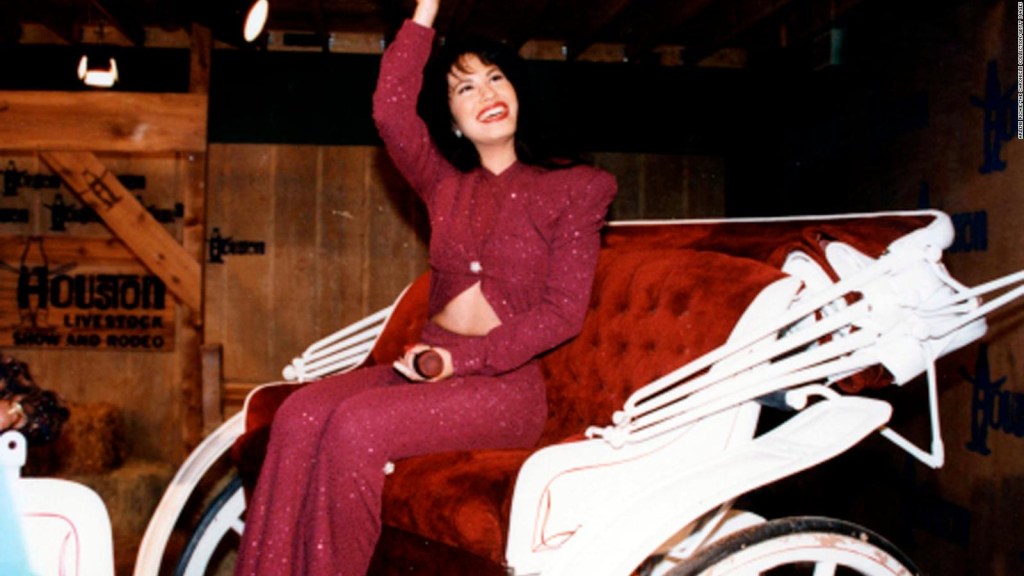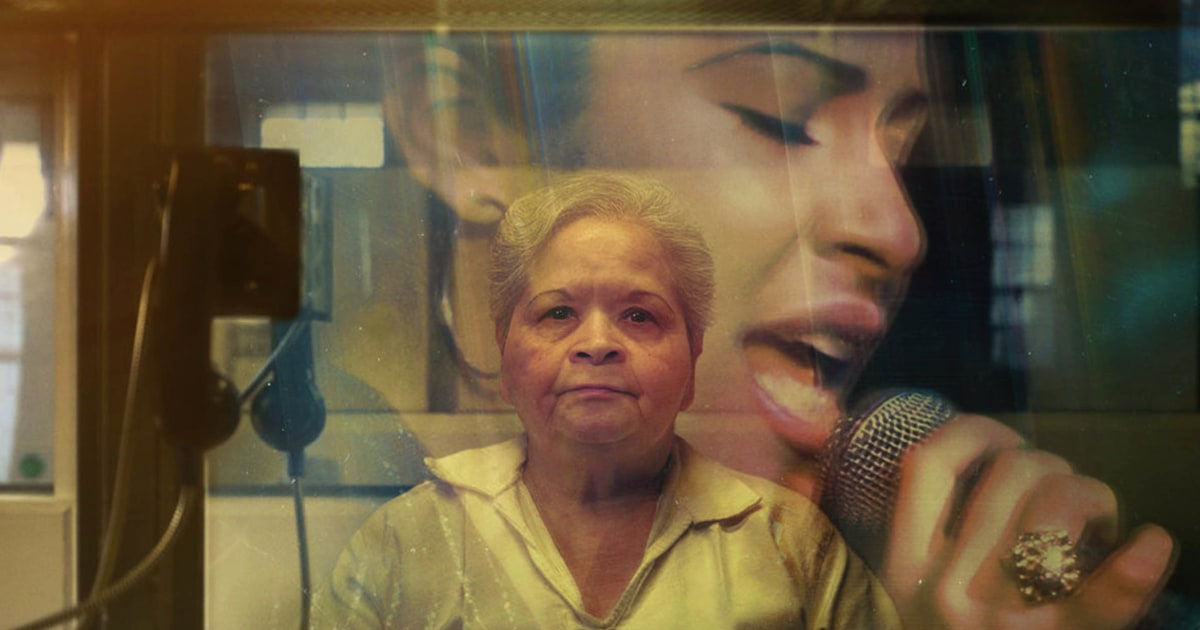Selena Quintanilla, immortalized in a US museum. 4:31
(CNN Spanish) ––
Selena Quintanilla was in the air, Selena was everywhere... you didn't discover her, you didn't have a memory of when was the first time you heard any of her songs.
This is how María García, executive director of Futuro Studios and creator of the award-winning podcast "Anything for Selena", describes the iconic singer nicknamed "La Reina del Tex-Mex".
María grew up in El Paso, Texas, and her world revolved around that border that splits your identity in two.
You are neither from here nor from there.
And this is what made people like her, and dozens more over the years – even after her death – feel identified with the singer.
"I grew up on the border, in El Paso, but also in Ciudad Juárez," María tells CNN Pop Zone.
"My cousins in Mexico called me pocha because I didn't speak Spanish very well and in truth I had never seen a star, an actress, a singer on television who spoke like me and that had a great impact on me," explains María.
Precisely that mirror is what attracted and continues to attract people to the figure that Selena represents today.
To understand Selena's impact, you have to understand history
Selena's first album was released in 1989, but it wasn't until 1992 that the singer had her first hit.
It was with "Como la flor", which comes off her third studio album "Entre a mi mundo".
And to understand a little why Selena made such an impression on the Hispanic community in the United States, you have to remember a little about the history and the feeling that there was among her citizens.
advertising
In the 1980s and 1990s, the country was experiencing the arrival of Mexican migrants, which was creating a conversation, Maria recalls, about how the United States was changing because of Latinos.
According to the 2000 census, the Hispanic population in the United States increased by 57.9%.
"
Across the country there was palpable anxiety about Latinos documented or not.
There was a fear in society that Latinos were not going to assimilate into American society.
The narrative that was presented the most about Mexican-Americans in particular was that they were gang members, dangerous and that they did not finish school, that they were teenage mothers, "he recounts.
María remembers that this was the image that the media projected of Latinos.
It is in this context that Selena Quintanilla appears with Los Dinos, a family band of healthy people, and that image became a symbol among the Latino community.
"Selena was someone with a very, very clean image. Selena was always a symbol, whether she wanted it or not. While the country was preoccupied with this anxiety about Latinos and Latino growth in America, Selena was a clean, hard-working example of the American dream and was one of the most visible Mexican-Americans in the country at the moment," Maria explains.
That success in music was a reflection to his community that dreams could be achieved.
The artist who spoke and looked like her people
One of the aspects, Maria recalls, that made her magnetism about Selena is that she spoke like her.
"She spoke very similar to me and that shocked me a lot. I was shocked to see a woman who spoke the same English and the same border Spanish as me," says María.
"When she died I was 9 years old, I remember that it was the first time I saw that my two worlds, my world in the United States and my world in Mexico, were sharing something. [The news of his death] was the most important thing on the news in the United States and in Mexico as well," he describes.
From that
spanglish
to her long hair with texture and
frizz,
many aspects of what makes Selena an icon today, is what connected with Latinos in the United States in the nineties.
"
I remember that the first thing I saw of her was her long, black hair, her iconic big earrings, her iconic red lipstick, and now, as a journalist, I understand why I was shocked to see these little details in her." Maria explains. "She had a look that was very informed by her growth in a working-class Latino community.
She never left her roots, even when she was a very famous artist who was filling international stadiums in different countries and who won the Grammy, she still dressed, combed her hair, put on makeup, spoke like our cousins, like our neighbors, like our aunts. and he never ceased to be a part of us"
.
Selena's power: she reached hearts with her voice
In the film "Selena" (1997), directed by Gregory Nava, the beginnings of the singer are portrayed.
Her father, Abraham Quintanilla, saw from a tender age his daughter's natural talent for acting.
She started singing music in English and little by little she came to music in Spanish, to her cumbias that made her so famous.
On the tape, his father (played by Edward James Olmos) tells him that music has to come from the heart.
"
If you want to be a singer, you have to sing to people from the depths of here
[gestures to the heart].
And do you know what's there? The heart,"
says Abraham Quintanilla to a little Selena at the beginning of the tape.
And that is what he finally projected as great.
Her music came –and continues to come– straight to the hearts of the people.
And it's more than the lyrics and the voice, it's the artist's interpretation that makes the difference.
"
She was a tremendous artist, how she sang, how she interpreted the songs that seemed like she could sing any emotion and you felt it, you felt how she sang.
If she sang of loss, of pain, she did it and interpreted it in such a way that you felt the feeling in your car, "says María.
Made history for women in the genre
We also owe Selena the growing presence of women in the Mexican regional genre, historically dominated by men.
If you like, she broke a glass ceiling for her colleagues, to the point that in 1993 she made history by being the first woman of the Tejano genre to win the Anglo-Saxon Grammy for best Mexican-American album, a category that changed over the years and is now known as as best regional Mexican music album (including Tejano).
"Her dad told me that when Selena started her career, many people didn't believe in her because the Texan genre and the Mexican ranchero genre were controlled by men and there was a thought that people weren't going to go see a woman, that women went to see men, and that women didn't want to see another woman in the scene," says María.
"With Selena the opposite happened, she was so
relatable
, she was a person that we saw in her, that women saw in her and that she could be sexy, but at the same time have autonomy of her body and her image. It was something very powerful, something very impactful. And I think that she broke barriers in the genre and not only in music, but her legacy can be seen in many parts of modern Latin culture, "he adds.
Five songs to celebrate Selena's legacy
The best way to remember and celebrate the legacy of the "Queen of Tex-Mex" is with her music.
María shared with us five of her favorite songs by the singer, perfect for different moments, from karaoke to dancing.
To dance: "La carcacha"
"
La carcacha
has a very tasty
beat
, a very emblematic cumbia of hers. You hear the joy in her voice. The song is very funny".
One hit: "Sukiyaki"
"
One of her
hits
that I think doesn't get the attention it deserves is
Sukiyaki
, which is Selena and the Dinos' interpretation of a Japanese song, but she sings it so softly, you hear the power of her voice and how she could change her voice and the power of her performance in that song.
A perfect ranchera for karaoke: "I have no more"
"His
Dad told me that it's his favorite song by Selena, that he listens to it a lot and thinks about it a lot with
I have no more left
.... But you know?
That song is about resignation.
It's really when you resign yourself to the loss of a love and accept it.
And it's an example where you can hear how she could sing about these very universal human themes: love, loss, and how you could hear the feeling of her in her voice."
A song in English: "I'm getting used to you"
"It's her song in English, a song that she recorded for the album she was recording in English when she died. And I like this song because it's an example of what Selena was going to be, of the potential she still had, of what It could have been and it is heard that he was going to be a pop star".
One of his beginnings: "Kisses"
"
It's a cumbia that Selena recorded on one of her first albums and it was cumbia where the band knew that their sound was cumbia.
Before that they had experimented a lot, they had even made
freestyle
songs ,
techno
, tejano, rancheras and they were experimenting, trying to find their most emblematic sound.
And with this song,
Besitos
, is where the sound of the band changes.
After that is when they produce their most popular cumbias".
Music Zone PopSelena Quintanilla




/cloudfront-eu-central-1.images.arcpublishing.com/prisa/N2BE2XZPH66LPLH5V5X4WDOOHI.jpg)





/cloudfront-eu-central-1.images.arcpublishing.com/prisa/2C5HI6YHNFHDLJSBNWHOIAS2AE.jpeg)



